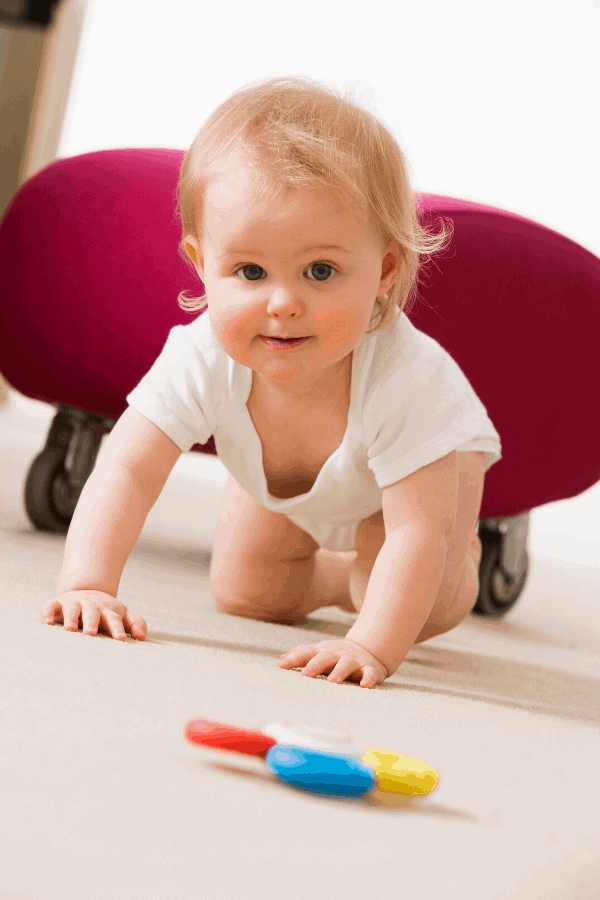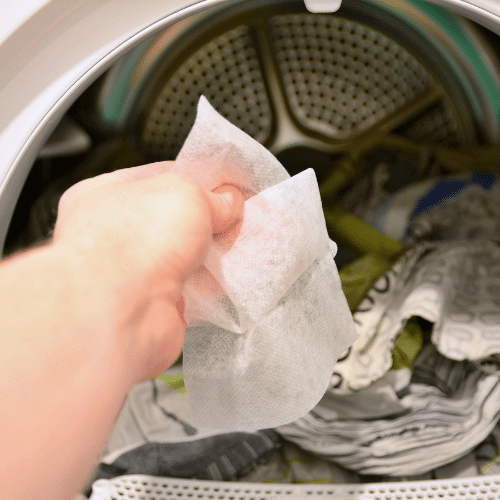Tummy time isn’t just a fun bonding activity for you and your baby, experts say that tummy time has a lot of benefits for your baby. This includes:
• Helps babies develop the neck and shoulder strength they need so they can lift themselves up to sit, roll over, crawl, and finally, walk.
• Helps promote overall motor skills
• Can help prevent positional plagiocephaly (flat head syndrome)
• Can also help babies relieve gas
Tummy time also helps babies meet their milestones in motor (sitting, crawling, walking…) sensory (touching different textures, body awareness, balance…), and vision (eye and hand coordination).
So, you see, tummy time is more than play. It helps your baby develop his overall health.

As an Amazon Associate I earn from qualifying purchases. The links below may be affiliate links. Please read my disclosure policy for more information.
Materials Needed for Tummy Time Activities
All you need to do for tummy time activities is to put your baby on a flat surface (preferably with a mat or a blanket) on his or her stomach.
You also need to consider the safety of your baby and at the same time, might as well make it fun, too!
Especially for when your baby has grown a few months older. Tummy time can be a rewarding moment for both mother and child.
Here are some of the materials/tools that you may want to prepare for tummy time to make it more fun:
• Hypoallergenic play mat that comes with a prop pillow – this is great for newborns as it helps prop them up and lift their heads
• Jungle gyms – makes tummy time fun for babies, it also encourages them to lift their bodies up to reach dangling toys
• Colorful tummy time toys – Adding toys with bright primary colors help brain stimulation
• A mirror – (for babies over 3 months old) this can help capture your baby’s attention thus encourages him to lift his head longer
• Tummy time teether toys – Helps babies learn how to use their hands and develops eye-hand coordination
• Interactive tummy time toys – Keeps babies entertained with its sounds
• Tummy time cloth books – helps develop love for books
• Tummy time noise makers – can encourage babies to reach for the toy to help develop muscles
Just make sure that you are choosing age-appropriate toys and follow choking hazard safety instructions.
Related: Toddler Climbing Out of Crib: Solutions and Hacks!

Safety in Tummy Time Activities for Infants
Safety should always be a top concern when it comes to any baby activity. Some safety precautions but not limited to:
• Make sure that tummy time is done only when the baby is fully awake
• Never leave your baby during tummy time alone nor allow him to sleep on his stomach
• Use of age appropriate toys and tummy time tools
• Talk to your pediatrician for advice and tips
How Long Should Daily Tummy Time Be?
Each baby is different and may have different needs including how much tummy time they need but below is the recommended tummy time duration according to baby’s age.
As always, if you have concerns about your baby and his milestones, check with a medical expert.
• Newborns – up to 5 minutes, 3 times/day
• 1 month – up to 10 minutes, 3 times/day
• 2 months – up to 20 minutes/day (can be split in different sessions)
• 3 months – up to 30 minutes/day (can be split in different sessions)
• 4 months – up to 40 minutes/day (can be split in different sessions)
• 6 months + – up to an hour per session
Related: Essential oils for baby congestion
Recommended Age Appropriate Tummy Time Activities for Babies
Tummy Time Activities for Newborns and Infants:
For newborn babies, you may want do tummy time using tummy to tummy or tummy to chest methods.
Place your baby on his stomach over your tummy or chest and hold the baby firmly.
You can also try the football hold. For this, you need to hold your baby with one arm and carry the baby tummy down with his head resting on your upper forearm near your elbow.
Hold your baby’s head and neck with your other hand for support and keep your baby close to your body.
Another method is to place your baby across your lap, face down, then use both your hands to support your baby,

Related: Natural Ways to Treat and Prevent Diaper Rash
Tummy Time Activities for 1-month-old Baby
Tummy time should now be done on the floor. Use a thick blanket or a play mat to protect them and encourage baby to look side to side by using rattlers or toys.
Get him to look around to develop neck muscles to help avoid positional torticollis.
Tummy Time Activities for 3-month-old
You will notice that your baby may start putting weight on his arms. You can slowly introduce toys around this time to help encourage them to look for it and move their heads around.
Related: 5 Reasons to Buy an Organic Crib Mattress
4-month-old Tummy Time Activities
At this point, your baby can lift his head with no problem and can push himself up using his forearms.
At this time, you can introduce toys that that they can track, or those that make sounds.
You can also introduce the mirror at this age to keep them engaged during tummy time.
Tummy Time Activities for 6-month-old
At 6 months old, your baby may start propping himself up using his arms and may start grabbing toys that attract them.
They can now pivot in place and can roll over easily. Use colorful toys to attract their attention and to motivate them to move around.
This is also the best time to introduce tummy time activities that encourage crawling since on average, babies start crawling at around 6 months.
But it is also perfectly normal if your baby doesn’t want to do it yet and shows no sign of interest in crawling. Just get your cue from your baby, you’ll know when he is ready because he will start pushing himself forward using his legs.
Related: When should I buy my baby walking shoes

Tummy Time Activities for 9-month-old
At 9 months, your baby can definitely move around and may start kneeling.
A sign that your baby is about to move up to the next milestone which is walking. They might even prefer crawling over tummy time and that is a good sign!
With increased muscle control, this means you need to be more watchful over your baby’s movements. It’s time to up your childproofing game and set up the safety gate!
Best Tummy Time Activities for the Resistant Baby
Some babies enjoy tummy time and get excited about it, however, there are some babies who dislike this activity and will not hesitate to let you know by crying and refusing to cooperate. Here’s what you can do:
Shorten tummy time period, instead of aiming for 5 minutes, keep it under 2 minutes, and slowly work it up to longer tummy time sessions as your baby learns to like it
You can also try doing tummy time in a different location. Perhaps he is tired of looking at the bedroom floor? Try outside or even in a shaded area of the garden! Just remember, safety first!
Encourage other siblings to join the fun. Perhaps an older child can sit or lay on the floor with the baby. Maybe a new company will make him interested.
Introduce age-appropriate toys to make tummy time more interesting and fun
Sing and move around the baby to catch their attention and perhaps this will make them forget that they do not like tummy time
Still need more ideas? You can always look for tummy time activities printout templates online so that you can have a visual guide.
Related: 7 ways to use a baby play table

What to do if baby isn’t showing any of these milestones?
Should you notice something off and your baby isn’t meeting his or her milestones, write down your observations and discuss your concerns with your baby’s pediatrician. Talk to a medical expert if you notice the following:
• Baby can’t pull his head forward as you pull him up
• Does not respond to rattle toys, sounds, or your voice
• Has difficulty putting things to his mouth
• Looks very stiff most of the time
• Does not even try to reach to things around him
• Looks floppy and lacks muscle control
If you notice any of this, bring your child to his pediatrician so he can be screened for general development and for proper medical advice.
Related: 10 Top Tips To Prevent And Treat Cradle Cap
In closing
Tummy time is an important part of the daily routine that you need to establish with your baby as it helps them develop their head, neck and shoulder muscles – all of which they will need to meet the other milestones later in their childhood years.
But aside from this, tummy time is a great opportunity for you to bond with your baby. Use this time to sing, talk and play with your baby because this stage won’t last long.
Soon enough, you will be chasing a toddler who prefers playing with friends over mommy. So, savor every moment!
Always remember though that each baby is different, and some babies take more time. Don’t get discouraged if your baby doesn’t seem to be interested at first!
Just continue the daily tummy time because no matter how short, each tummy time session is a step towards helping your baby achieve overall gross motor development.






